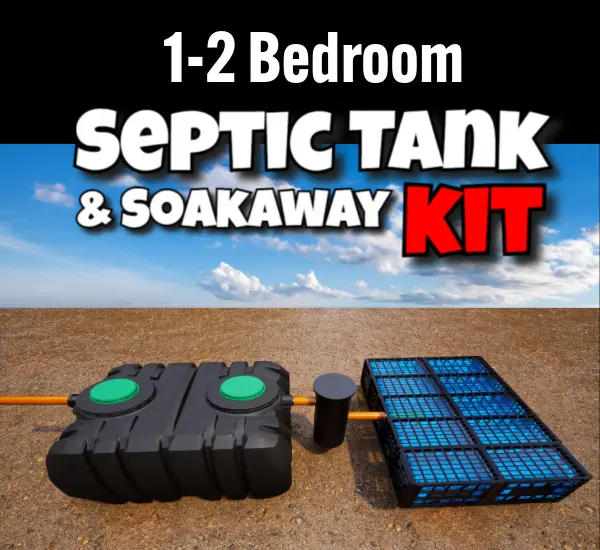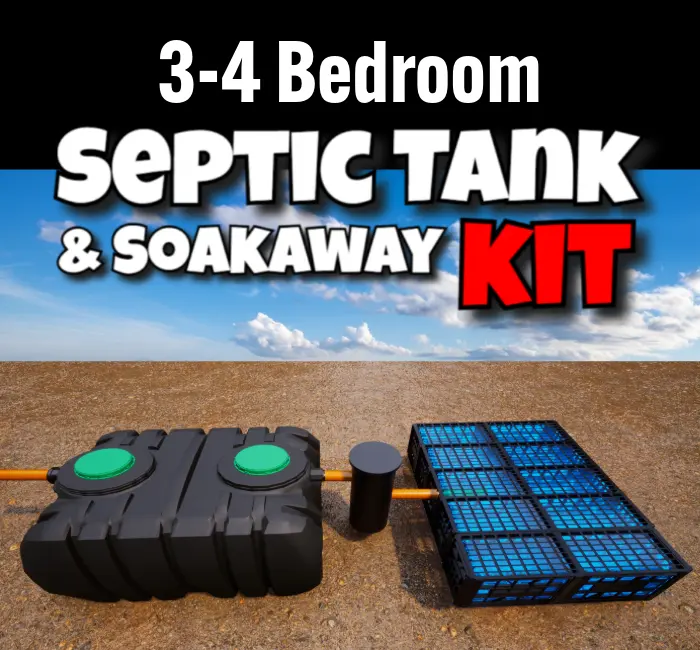Comprehensive Guide to Septic Tank Installation in the UK
Septic tank installation is a critical process for properties without access to mains sewer systems, particularly in rural areas of the UK. Whether you’re a homeowner, business owner, or developer, understanding the ins and outs of septic tank installation can save you time, money, and potential regulatory headaches. This extensive 8000–9000-word guide provides a detailed overview of septic tank systems, including types of tanks, installation methods, costs, regulations, and innovative solutions like shallow dig systems and drainage field crates. For more resources on septic systems, visit Builders Yard UK or explore our septic tank range.
What is a Septic Tank and How Does It Work?
A septic tank is an underground wastewater treatment system that collects, treats, and disperses sewage from properties not connected to mains drainage. Typically used in rural or remote areas, septic tanks are essential for managing household or commercial wastewater safely and in compliance with UK regulations.
The system works through a multi-stage process:
- Collection: Wastewater from toilets, sinks, and appliances flows into the septic tank.
- Separation: Inside the tank, solids settle to the bottom as sludge, while lighter materials like grease form a scum layer on top. The liquid effluent remains in the middle.
- Treatment: Anaerobic bacteria within the tank break down organic matter in the sludge and scum, partially treating the wastewater.
- Discharge: The treated effluent flows into a drainage field (also called a soakaway), where it percolates through the soil for further natural treatment before re-entering the groundwater system.
Septic tanks require periodic maintenance, such as desludging every 1–3 years, to ensure efficient operation. According to the Environment Agency, septic tanks must comply with General Binding Rules to prevent environmental pollution.
Why Install a Septic Tank?
Septic tanks are a necessity for properties without access to mains sewer systems. They offer several benefits:
- Independence: Septic tanks provide a self-contained wastewater solution, eliminating reliance on public utilities.
- Environmental Compliance: Properly installed systems treat wastewater safely, protecting local watercourses and groundwater.
- Cost-Effectiveness: While initial installation costs can be high, septic tanks have lower ongoing costs compared to sewer connection fees.
- Versatility: Suitable for various property types, including homes, businesses, campsites, and glamping sites.
However, installation requires careful planning to meet regulatory standards and suit site-specific conditions, such as soil type and water table levels.
Types of Septic Tanks: Plastic, Fibreglass, and Concrete
Septic tanks come in three primary materials: plastic (HDPE), fibreglass, and concrete. Each has distinct advantages and drawbacks, influencing cost, installation, and longevity. Below, we explore these options in detail.
1. Plastic Septic Tanks (HDPE)
High-density polyethylene (HDPE) plastic septic tanks are lightweight, durable, and increasingly popular in the UK due to their affordability and ease of installation.
- Pros:
- Lightweight: Easy to transport and install, reducing labour and equipment costs.
- Corrosion-Resistant: Immune to rust and chemical degradation, ideal for acidic or wet soils.
- Affordable: Typically priced between £2000–£5000, making them cost-effective.
- Shallow Dig Compatibility: Many HDPE tanks are designed for shallow excavations (1–1.5m), minimizing digging costs.
- Certified: Compliant with EN 12566-1 standards for durability and performance.
- Cons:
- Less Robust: May require reinforcement in high-traffic areas to prevent deformation.
- Buoyancy Risk: In high water table areas, tanks may need anchoring to prevent floating.
Plastic tanks are ideal for DIY installations or properties with limited space, as their compact design and shallow dig requirements simplify the process.
2. Fibreglass Septic Tanks
Fibreglass tanks, made from glass-reinforced plastic, offer a balance of strength and weight, making them suitable for challenging ground conditions.
- Pros:
- Strong and Durable: Resistant to soil pressure and suitable for areas with heavy vehicle traffic.
- Corrosion-Resistant: Long lifespan of 30–50 years with proper maintenance.
- Moderate Weight: Lighter than concrete, easing installation compared to heavier alternatives.
- Cons:
- Higher Cost: Priced between £3000–£7000, more expensive than plastic tanks.
- Cracking Risk: Can crack under extreme pressure if not installed correctly.
- Limited Availability: Less common than plastic or concrete tanks in the UK market.
Fibreglass tanks are a good choice for properties requiring a robust system without the heavy installation demands of concrete.
3. Concrete Septic Tanks
Concrete septic tanks, often called “onion” tanks due to their spherical shape, are traditional and highly durable but come with significant installation challenges.
- Pros:
- Extremely Durable: Can last 50+ years with proper maintenance.
- Stable: Heavy weight prevents buoyancy in high water table areas.
- Heavy-Duty: Suitable for large properties or commercial applications.
- Cons:
- Heavy: Requires cranes or heavy machinery for transport and installation, increasing costs.
- Concrete Surround: Needs a 150mm concrete base and surround, adding £1000–£2000 to costs.
- Deep Excavation: Typically requires 2–3m depth, increasing labour and equipment expenses.
- Cracking Risk: Prone to cracking in unstable soils.
- High Cost: Priced between £5000–£10,000, making them the most expensive option.
Concrete tanks are best for large-scale applications or areas with high water tables, but their cost and installation complexity make them less appealing for smaller properties.
Comparison Table: Plastic vs. Fibreglass vs. Concrete Septic Tanks
| Feature | Plastic (HDPE) | Fibreglass | Concrete |
|---|---|---|---|
| Cost | £2000–£5000 | £3000–£7000 | £5000–£10,000 |
| Weight | Lightweight | Moderate | Heavy |
| Installation Time | 3–6 hours | 6–12 hours | 1–2 days |
| Durability | 25–50 years | 30–50 years | 50+ years |
| Corrosion Resistance | High | High | Moderate |
| Excavation Depth | Shallow (1–1.5m) | Moderate (1.5–2m) | Deep (2–3m) |
| Best For | DIY, small gardens, clay soil | Heavy traffic areas | High water tables, large sites |
For most UK properties, plastic (HDPE) tanks offer the best balance of cost, ease of installation, and performance, especially when paired with modern drainage field solutions.
Septic Tank Installation Costs in the UK
The cost of septic tank installation in the UK typically ranges from £12,000 to £20,000, depending on factors like tank material, site conditions, and labour rates. Here’s a breakdown of the key cost components:
- Tank Purchase: £2000–£10,000, depending on material and size.
- Excavation: £1500–£3000, influenced by soil type, depth, and equipment needs.
- Labour: £4000–£7000 for professional installations, including pipework and drainage field setup.
- Concrete Surround (for concrete tanks): £1000–£2000 for materials and labour.
- Drainage Field: £1000–£3000, depending on size and materials (e.g., gravel vs. crates).
- Permits and Inspections: £200–£500, if required by local authorities or the Environment Agency.
Professional installations often reach £18,000 due to these combined costs. However, innovative solutions like DIY septic tank kits can significantly reduce expenses, as discussed below.
Shallow Dig Septic Tanks and Drainage Field Crates: A Cost-Saving Solution
Traditional septic tank installations, particularly those using concrete tanks, require deep excavations (2–3m) and extensive labour, driving up costs. Modern shallow dig, low-profile septic tanks paired with drainage field crates offer a cost-effective alternative, saving thousands in time and money. Here’s how:
Benefits of Shallow Dig Septic Tanks
Shallow dig septic tanks, often made from HDPE, are designed to be installed at depths of 1–1.5m, compared to 2–3m for concrete tanks. This reduces:
- Excavation Costs: Less digging means lower digger hire and labour costs, typically saving £500–£1500.
- Installation Time: Shallow dig systems can be installed in 3–6 hours, compared to 1–2 days for concrete tanks, reducing labour expenses.
- Concrete Requirements: Unlike concrete tanks, HDPE tanks don’t need a concrete surround, saving £1000–£2000.
- Site Disruption: Smaller excavations minimize damage to gardens or driveways, reducing restoration costs.
These tanks have a compact footprint, making them ideal for small gardens or properties with limited space, such as those found in rural UK settings.
Advantages of Drainage Field Crates
Drainage field crates are modular plastic units that replace traditional gravel-based soakaways. They offer several advantages:
- High Void Ratio: Crates provide 95% void space for effluent dispersal, compared to 30–40% for gravel, ensuring faster and more efficient drainage.
- Compact Footprint: Require less land area than herringbone soakaways, ideal for small or constrained sites.
- Clay Soil Compatibility: Positioned 500mm below the surface, crates avoid dense clay layers, improving drainage in poor soil conditions.
- Durability: Made from robust plastic, crates are resistant to soil pressure and can support driveways.
- Easy Installation: Modular design simplifies setup, reducing labour time and costs.
According to British Water, drainage field crates are an approved solution for septic tank systems, ensuring compliance with UK regulations.
Cost Savings Example
A professional installation for a 3-4 bedroom property might cost £18,000, including a concrete tank (£6000), excavation (£2500), labour (£6000), concrete surround (£1500), and drainage field (£2000). In contrast, a DIY septic tank kit from Builders Yard UK, priced at £3499, includes a shallow dig HDPE tank, pipes, connectors, and 10–14 drainage field crates. With £500 for digger hire and £500 for labour, the total cost is £4499, saving £13,501. This approach is particularly effective in clay soils, where shallow drainage fields perform better.
DIY Septic Tank Installation: Is It Feasible?
DIY septic tank installation is a viable option for those looking to save on labour costs, provided they follow proper guidelines and regulations. Modern septic tank kits, like those available from Builders Yard UK, are designed for ease of installation, requiring no prior experience. Here’s a step-by-step guide to DIY installation:
- Site Assessment: Evaluate soil type, water table, and distance from watercourses. Consult a percolation test to ensure the drainage field will function effectively.
- Obtain Permissions: Check with your local planning authority and the Environment Agency for permits, especially if discharging over 2 cubic metres per day.
- Excavate: Dig a 1–1.5m deep hole for the tank and drainage field using a 1.5, 3, or 5-tonne digger.
- Install Components: Place the septic tank, inspection chamber, and drainage field crates in the excavated area.
- Connect Pipework: Use 110mm pipes and connectors to link the tank to the house drain and drainage field.
- Backfill: Fill with soil or gravel, ensuring no concrete is needed for HDPE tanks.
- Test the System: Check for proper flow and leaks before covering completely.
DIY kits typically take 3 hours to install, compared to 1–2 days for professional setups. However, always consult a professional if unsure about site conditions or regulations.
UK Regulations for Septic Tank Installation
Septic tank installation in the UK is governed by strict regulations to protect public health and the environment. Key requirements include:
- General Binding Rules: Introduced in 2015 and updated in 2020, these rules prohibit septic tanks from discharging directly to watercourses (e.g., rivers, streams). Effluent must discharge to a drainage field, as outlined by the Environment Agency.
- Building Regulations: Part H of the Building Regulations requires septic tanks to be installed with adequate drainage and waste disposal systems, as per the Planning Portal.
- British Standards: Tanks must comply with BS 6297:2007+A1:2008 and EN 12566-1 for design and performance.
- Permits: If your discharge exceeds 2 cubic metres per day or your property is within 30 metres of a public sewer, you may need a permit from the Environment Agency.
Failure to comply can result in fines or costly remediation. Always consult your local planning authority and the Environment Agency before starting installation.
Attenuation Crates: Enhancing Septic Systems
Attenuation crates are modular plastic units used to manage stormwater, often complementing septic tank systems in rural properties. They store and slowly release rainwater, preventing flooding in areas with poor drainage. Key benefits include:
- Flood Prevention: Reduces surface water runoff, protecting the septic system from overload.
- Compact Design: Fits in small spaces, ideal for properties with limited land.
- Regulatory Compliance: Approved by UK Building Control and the Environment Agency for stormwater management.
Attenuation crates are available in various sizes (e.g., 4 pop to 100 pop), making them suitable for both small homes and large commercial sites. For more information, visit Builders Yard UK.
Septic Tank Maintenance: Ensuring Longevity
Proper maintenance is essential to keep your septic tank functioning efficiently and compliant with regulations. Follow these tips:
- Desludging: Remove sludge every 1–3 years using a registered waste carrier.
- Avoid Harmful Substances: Don’t flush non-biodegradable items (e.g., wipes, sanitary products) or chemicals (e.g., bleach, paint).
- Conserve Water: Reduce water usage to prevent overloading the system.
- Inspect Regularly: Check the drainage field for pooling or odours and use the inspection chamber for routine checks.
Regular maintenance prevents costly repairs and ensures compliance with Environment Agency standards.
Common Challenges in Septic Tank Installation
Septic tank installation can face several challenges, depending on site conditions and regulations:
- Clay Soil: Heavy clay soils have poor drainage, requiring larger drainage fields or shallow systems like crates.
- High Water Table: Areas with high groundwater levels may cause tanks to float or drainage fields to fail, necessitating anchoring or alternative systems.
- Proximity to Watercourses: Tanks must be at least 7 metres from watercourses to prevent pollution, as per Environment Agency rules.
- Planning Permissions: Some installations require approval from local authorities, adding time and cost.
Modern shallow dig systems and drainage field crates address many of these challenges, offering flexible solutions for difficult sites.
FAQ: Septic Tank Installation in the UK
What is the average cost of septic tank installation in the UK?
Professional septic tank installation typically costs £12,000–£20,000, including the tank, excavation, labour, and drainage field. DIY kits can reduce costs to £4000–£5000.
Do I need planning permission for a septic tank?
You may need planning permission if your property is near a public sewer or if the discharge exceeds 2 cubic metres per day. Contact your local planning authority and the Environment Agency for guidance.
Can I install a septic tank myself?
Yes, DIY installation is feasible with kits designed for ease of use, requiring no prior experience. However, ensure compliance with regulations and conduct a percolation test.
What are drainage field crates, and why use them?
Drainage field crates are plastic units that replace gravel soakaways, offering a high void ratio for faster effluent dispersal. They’re compact, durable, and ideal for clay soils.
How often should I desludge my septic tank?
Desludge every 1–3 years, depending on usage, using a registered waste carrier to maintain system efficiency.
Will a septic tank work in clay soil?
Yes, especially with shallow dig systems and drainage field crates positioned 500mm below the surface, which avoid dense clay layers for better drainage.
What are the General Binding Rules for septic tanks?
The General Binding Rules require septic tanks to discharge to a drainage field, not watercourses, and comply with size and location restrictions to prevent pollution.
Can I use a septic tank for a campsite or glamping site?
Yes, septic tanks are suitable for campsites and glamping sites, especially compact HDPE kits designed for small footprints and easy installation.
Conclusion: Making Informed Decisions on Septic Tank Installation
Septic tank installation is a significant investment for off-mains properties, but with the right knowledge, you can make informed decisions that save time, money, and ensure compliance. From choosing between plastic, fibreglass, and concrete tanks to leveraging shallow dig systems and drainage field crates, there are numerous ways to optimize your installation. By understanding costs, regulations, and maintenance, you can achieve a reliable, environmentally friendly wastewater solution tailored to your property’s needs.
For more information on septic tank systems and innovative solutions, visit Builders Yard UK or explore our septic tank range. Whether you opt for a professional installation or a DIY approach, this guide equips you with the tools to succeed.




